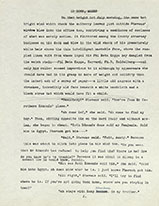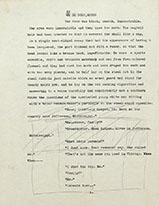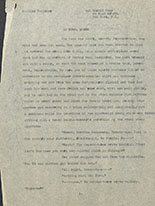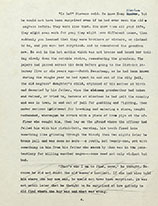Manuscripts Etc.
| CLOSE WINDOW |

|
The following items are drawn from the William Faulkner Foundation Collection at the University of Virginia's Albert and Shirley Small Special Collections Library (http://small.library.virginia.edu/). |
|
Faulkner wrote this story in July, 1940, about half a year after he introduced the black Beauchamp family into the Yoknapatawpha saga (see elsewhere in Digital Yoknapatawpha "A Point of Law," "Gold Is Not Always," and Go Down, Moses, the 1942 novel he published with the same name as the story), and also six months after the death of his own Negro "Mammy," Caroline Barr, the original from whom Mollie Beauchamp's character derives. The surviving typescripts can help us appreciate the complexity of the issues with which the story deals, including the relationships between the races in Yoknapatawpha, and the relationship between the white South and the urban North. Both these issues connect with another one Faulkner took on: the relationship between this story and the rest of his fictions. The earliest extant 14-page typescript is not Faulkner's first draft, since three of its pages were typed on the back of sheets from a still earlier version. That earlier version may have begun in Mississippi, as does the page below left. This is presumably a title page, since Faulkner typed the story's title at the top, though the "3" at its bottom references its place in that 14-page typescript. The first page of that later typescript can be seen below center. Like the published story, it begins on death row in an Illinois prison. Faulkner's uncertainty about fitting the condemned prisoner into the larger story of Yoknapatawpha can be seen in the cancelled second half of the page: calling him "Henry Coldfield Sutpen" and his grandmother "Rosa Sutpen" links him to Absalom, Absalom! (1936). Similarly, Mollie's brother was originally named "Hamp Benbow" (see below center), linking her and her grandson back to one of Yoknapatawpha's first families, as his mythical county came into focus in Flags in the Dust (1929) and Sanctuary (1931). Faulkner has settled on the final names for these characters by the time he typed the version below right; by using "Beauchamp" and "Worsham" instead of "Sutpen" and "Benbow," he frees them from the past he himself has created in those earlier novels, though it's too soon to say he has already begun to imagine the family he'll invent for the novel Go Down, Moses, the racially mixed McCaslin-Edmonds-Beauchamp family. This 17-page typescript may be the one that Faulkner, badly in need of money as usual, sent directly to the Saturday Evening Post, which declined to publish the story, though the fact that it's addressed to his agent, Harold Ober, may mean it's a still later revision; after the Post rejected it, Ober was able to sell the story to Collier's magazine, where it appeared in January, 1941.    The three pages below are all from the 14-page typescript. Page 2 (below left) follows from the end of the last uncancelled line on page 1, which may mean that Faulkner decided to revise "Sutpen" into "Beauchamp" even as he was typing this version. The page numbered 3 above center follows directly from page 2. The fact that Mollie's brother is still a "Benbow" on page 4 (below center) suggests Faulkner made that revision later, though presumably while still typing this version, since "Worsham" has been established by page 11 (below right). Page 11 describes Gavin Stevens' visit to Miss Worsham's house, in order to tell Mollie about the arrangements that he has made for bringing her grandson's body to Jefferson. This passage underwent several very interesting revisions between the typescript, the magazine and the novel versions of the text. In this typescript, the "ashes" smoldering on the hearth in Miss Worsham's bedroom make it seem "as though the room were a negro's room." In the 17-page typescript, Faulkner added the word "actually" to this phrase - "were actually a negro's room." The whole phrase has disappeared in the magazine version. A few lines later, the "hearth" is described as an "ancient symbol," though what it symbolizes changes too. In the typescripts and the magazine version, it's "physical coherence." The novel version is much warmer - "human coherence and solidarity." Both sets of changes indicate Faulkner's concern to find the right way to express the bond that links the white, aristocratic Miss Worsham with her servants, Hamp and his wife, and with Mollie, the Negro daughter of her grandfather's slaves with whom she "grew up together as sisters would."    Between 1916 and the 1930s, almost two million African Americans left the rural South to move into northern cities like Chicago. "Go Down, Moses" is one of the few texts in which Faulkner acknowledges this exodus. It's possible that the revisions you can see on these pages reflect his anxiety about how he wants to tell that story. As Samuel Worsham Beauchamp appears on the story's first page, he's lost almost every trace of his southern heritage - not just his accent, but his straightened hair and zoot suit identify him with that urban North. But to Mollie, and through association with her to Miss Worsham, he is still one of Yoknapatawpha's "native sons" - to borrow a term from Richard Wright, another Mississippi black who moved to Chicago - who deserves to be mourned and brought home. The "Pharaoh" Mollie holds responsible for his sorry life is his white Yoknapatawpha landlord, Roth Edmonds. On the other hand Gavin Stevens, the story's representative southern white man, lays the blame for the boy's violent life and death on his black father and, by implication, the white north, and unlike Miss Worsham he feels no grief over this death. But when he enters the revised story after readers meet the heartless killer in his cell, Stevens' generous, not to say chivalrous willingness to make sure Mollie's wish is fulfilled complements Miss Worsham's empathy for her loss, as expressed in the revised symbolism of the hearth. While it would drastically overstate the case to argue that the story may be suggesting "let my [black] people go [back south]," it does seem to say that, together, these two upper class white southerners take much better care of their black population than the North can or will. Citing this source:
|
